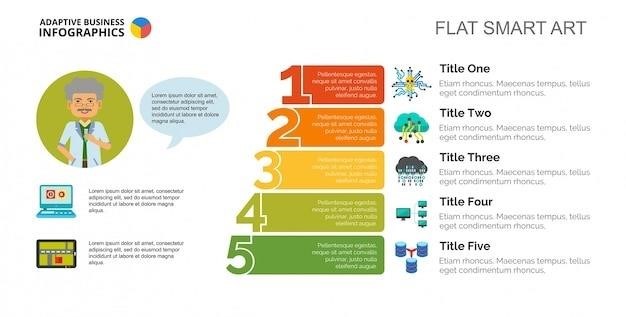SystemVerilog Tutorial⁚ A Comprehensive Guide
This comprehensive guide will delve into the world of SystemVerilog‚ a powerful hardware description and verification language widely used in electronic design automation. We will explore its fundamental concepts‚ advanced features‚ and applications in both design and verification. Whether you are a beginner or an experienced Verilog engineer‚ this tutorial will equip you with the knowledge to confidently utilize SystemVerilog in your projects.
Introduction to SystemVerilog
SystemVerilog is a hardware description language (HDL) and a hardware verification language (HVL) that has become the industry standard for designing and verifying complex digital systems. It is a powerful and versatile language that combines the best features of Verilog and other HDLs‚ offering a rich set of features for modeling‚ simulating‚ and verifying digital circuits. SystemVerilog is widely used in the semiconductor industry for designing integrated circuits (ICs)‚ field-programmable gate arrays (FPGAs)‚ and other digital systems.
SystemVerilog evolved from Verilog‚ adding object-oriented programming (OOP) concepts‚ advanced data types‚ and powerful verification features. It allows engineers to describe hardware at different levels of abstraction‚ from the gate level to the behavioral level. SystemVerilog’s ability to handle complex designs and its support for verification make it an essential tool for modern digital design and verification workflows.

SystemVerilog has become the language of choice for many design and verification teams due to its features and capabilities. Its adoption has significantly improved the efficiency and effectiveness of the design and verification process‚ enabling engineers to develop more complex and sophisticated digital systems.
Why SystemVerilog?
SystemVerilog has emerged as the preferred language for hardware design and verification‚ surpassing its predecessor Verilog‚ due to its numerous advantages. Its ability to handle complex designs with greater efficiency and its support for advanced verification techniques have made it an indispensable tool for modern digital design workflows. Here are some key reasons why SystemVerilog stands out⁚
- Enhanced Verification Capabilities⁚ SystemVerilog introduces powerful features for verification‚ such as object-oriented programming (OOP)‚ assertions‚ and coverage groups. These features enable engineers to create more comprehensive and robust testbenches‚ leading to higher quality designs and faster time-to-market.
- Increased Design Abstraction⁚ SystemVerilog supports various levels of abstraction‚ allowing engineers to describe hardware at different levels of detail. This flexibility enables more efficient design and verification processes‚ particularly for complex systems.
- Improved Code Reusability⁚ SystemVerilog’s OOP features promote code reusability‚ reducing development time and effort. Engineers can create reusable components and libraries‚ making the design process more efficient and scalable.
- Strong Industry Support⁚ SystemVerilog is widely adopted by leading EDA vendors‚ providing comprehensive tool support for simulation‚ synthesis‚ and verification. This widespread adoption ensures a rich ecosystem of tools and resources for engineers.
- Enhanced Debugging and Analysis⁚ SystemVerilog provides advanced debugging and analysis capabilities‚ enabling engineers to quickly identify and resolve issues during design and verification. These features streamline the debugging process and improve the overall development cycle.
SystemVerilog Data Types
SystemVerilog offers a rich set of data types that cater to the diverse needs of hardware design and verification. These data types provide the foundation for representing and manipulating various types of information within a SystemVerilog design. Understanding these data types is crucial for effectively modeling hardware behavior and creating accurate and efficient verification environments.

- Basic Data Types⁚ SystemVerilog provides basic data types like integers (int)‚ reals (real)‚ and logic (logic) that are fundamental for representing numerical values and logical states. These types are extensively used in hardware designs and verification.
- Nets⁚ Nets are used to model electrical connections in a circuit. They represent physical wires that transmit signals between different parts of a design. Common net types include wire‚ tri‚ and tri0.
- Variables⁚ Variables store data values within a design. They are used to hold temporary results‚ control flow‚ and manage data within a module. SystemVerilog provides different variable types like reg‚ integer‚ and real‚ each suited to specific applications.
- Enumerated Types⁚ Enumerated types (enum) allow you to define a set of named constants‚ improving code readability and maintainability. They are particularly helpful for representing states‚ modes‚ and other discrete values in your design.
- Arrays⁚ SystemVerilog supports arrays‚ enabling you to store collections of data elements. They are commonly used to represent memory‚ registers‚ and other data structures in hardware designs.
- Structures⁚ Structures (struct) provide a way to group data elements of different types into a single unit. They are useful for representing complex data structures like memory addresses‚ control registers‚ and other data aggregates.
Understanding SystemVerilog’s data types is essential for effective hardware design and verification. By choosing the appropriate data type for each variable‚ you can ensure the accuracy and efficiency of your SystemVerilog designs.
Operators in SystemVerilog
Operators are the building blocks of SystemVerilog expressions‚ enabling us to perform various operations on data values. They play a pivotal role in defining logic‚ manipulating data‚ and controlling program flow within a SystemVerilog design. SystemVerilog provides a comprehensive set of operators‚ categorized by their functionality‚ to handle a wide range of operations.
- Arithmetic Operators⁚ These operators perform basic mathematical operations‚ including addition (+)‚ subtraction (-)‚ multiplication (*)‚ division (/)‚ modulus (%)‚ and unary negation (-). They are fundamental for numerical calculations and data manipulation in SystemVerilog.
- Logical Operators⁚ Logical operators evaluate conditions and return true or false values. They are essential for decision-making and control flow. The logical operators include AND(&&)‚ OR (||)‚ NOT (!)‚ and XOR (^).
- Relational Operators⁚ Relational operators compare values and return true or false based on the comparison result. They are crucial for conditional statements and data comparisons. The relational operators include equality (==)‚ inequality (!=)‚ greater than (>)‚ less than (<)‚ greater than or equal to (>=)‚ and less than or equal to (<=);
- Bitwise Operators⁚ Bitwise operators perform operations on individual bits of data. They are commonly used in hardware designs for bit manipulation‚ data masking‚ and other bit-level operations. Bitwise operators include AND (&)‚ OR (|)‚ XOR (^)‚ NOT (~)‚ left shift (<<)‚ and right shift (>>).
- Reduction Operators⁚ Reduction operators apply a logical or arithmetic operation to all bits of an operand‚ producing a single result. They are often used for bitwise operations like checking if all bits are set or if any bit is set.
- Conditional Operator⁚ The conditional operator (?⁚) provides a concise way to evaluate a condition and return one of two values based on the result. It offers a compact alternative to traditional if-else statements.
Understanding SystemVerilog’s operators is essential for writing efficient and expressive code. By selecting the appropriate operators for your design‚ you can create clear‚ concise‚ and functional SystemVerilog code that accurately represents the intended hardware behavior.
Control Flow Statements
Control flow statements are the backbone of program execution‚ dictating the order in which instructions are executed. They allow us to create dynamic and responsive behavior within our SystemVerilog designs. SystemVerilog provides a powerful set of control flow statements‚ enabling us to implement complex logic and control the flow of execution based on specific conditions. These statements empower us to create sophisticated designs capable of handling diverse scenarios and responding effectively to changing conditions.
- if-else Statements⁚ The if-else statement is a fundamental control flow construct that allows us to execute different code blocks based on a condition. It provides a way to make decisions within our SystemVerilog designs‚ enabling them to respond differently to various input values or events.
- case Statements⁚ The case statement provides a structured way to handle multiple conditions‚ offering a more efficient approach than nested if-else statements for scenarios with many possible outcomes. It simplifies our code and enhances its readability.
- for Loops⁚ The for loop is a powerful tool for iterating through a sequence of values‚ executing a block of code repeatedly. It allows us to perform operations on a series of data or to repeat a process a specified number of times‚ automating repetitive tasks within our designs.
- while and do-while Loops⁚ The while and do-while loops provide flexible ways to repeat a block of code until a specific condition is met. They enable us to implement tasks that continue as long as a condition remains true‚ allowing for iterative processes within our SystemVerilog designs.
- forever Loops⁚ The forever loop provides a mechanism for continuous execution‚ repeating a block of code indefinitely. This is particularly useful in designs where a process needs to run continuously‚ such as monitoring inputs or controlling specific hardware elements.
Control flow statements are essential for creating robust and dynamic SystemVerilog designs. By mastering these statements‚ we can effectively control the flow of execution‚ implement complex decision-making processes‚ and automate repetitive tasks‚ leading to more efficient and sophisticated designs.
Modules and Hierarchy
SystemVerilog employs a modular design approach‚ allowing us to break down complex designs into smaller‚ manageable units called modules. This modularity not only enhances code organization but also promotes reusability and simplifies the design process. Modules act as building blocks‚ encapsulating specific functionalities within their boundaries. This encapsulation promotes code readability and maintainability‚ making it easier to understand and modify individual components of a design.
Modules can be interconnected to create hierarchical structures‚ reflecting the natural organization of complex systems. This hierarchical structure allows us to build increasingly sophisticated designs by combining modules into larger‚ more intricate units. Each module acts as a self-contained entity‚ interacting with other modules through well-defined interfaces. This approach simplifies the design process‚ allowing us to focus on the functionality of each module without being overwhelmed by the complexity of the entire system.
- Module Declaration⁚ Modules are declared using the “module” keyword‚ followed by the module name and a list of input and output ports. These ports act as communication channels between modules‚ enabling data exchange and interaction within the hierarchical design.
- Module Instantiation⁚ To incorporate a module within another module‚ we use “instantiation”. This involves creating an instance of the module and specifying the connections between its ports and the ports of the parent module. Instantiation allows us to reuse modules across different parts of a design‚ promoting code efficiency and reducing redundancy.
- Hierarchical Design⁚ Modules can be nested within other modules‚ creating hierarchical structures that mirror the organization of complex systems. This hierarchical approach allows us to build large‚ complex designs by breaking them down into smaller‚ manageable units.
Modular design and hierarchical structures are fundamental principles in SystemVerilog‚ enabling us to create complex and efficient designs. By embracing these principles‚ we can build systems that are both modular and scalable‚ allowing us to handle the ever-increasing complexity of modern electronic designs.
SystemVerilog for Verification
SystemVerilog’s strength lies not only in its ability to describe hardware but also in its powerful features for verifying the correctness of designs. Verification plays a critical role in ensuring that a design meets its specifications and functions as intended. SystemVerilog provides a comprehensive set of tools and constructs specifically tailored for this purpose‚ enabling us to create robust and effective verification environments.
SystemVerilog’s verification capabilities are particularly evident in the realm of testbenches. Testbenches act as virtual environments that stimulate the design under test‚ providing inputs and observing its outputs to assess its behavior. SystemVerilog offers advanced features like random constraints‚ coverage analysis‚ and assertions to enhance testbench functionality and streamline the verification process.
Random constraints allow us to generate a wide range of test cases automatically‚ covering various input scenarios. This helps ensure that the design is tested thoroughly against a diverse set of inputs‚ increasing the likelihood of detecting potential errors. Coverage analysis provides insights into the effectiveness of the test suite‚ highlighting areas that haven’t been adequately tested. Assertions‚ on the other hand‚ act as formal specifications‚ ensuring that the design behaves as intended throughout its execution.
SystemVerilog’s verification features‚ combined with its hardware description capabilities‚ make it a powerful tool for both design and verification. This dual functionality streamlines the development process‚ allowing us to create complex systems that are not only functional but also thoroughly tested and validated.
Testbenches and Assertions
Testbenches‚ the cornerstone of SystemVerilog verification‚ serve as virtual environments that simulate the design under test‚ providing inputs and observing its outputs to validate its functionality. They are meticulously crafted to mimic the real-world conditions in which the design will operate‚ ensuring thorough testing and uncovering potential flaws. SystemVerilog’s testbench capabilities are further amplified by the use of assertions‚ a powerful mechanism for formally specifying and verifying design behavior.
Assertions act as explicit statements that define the expected behavior of the design. They are written in a concise and declarative manner‚ stating the conditions that must hold true during execution. SystemVerilog provides a rich set of assertion constructs‚ enabling us to express various types of checks‚ including property-based assertions‚ temporal assertions‚ and coverage assertions.
Property-based assertions specify the desired behavior of a design based on a sequence of events or conditions. Temporal assertions‚ on the other hand‚ focus on verifying the timing relationships between events‚ ensuring that they occur within the expected timeframes. Coverage assertions are designed to track the execution of the design and ensure that all critical code paths are adequately tested. Assertions‚ in conjunction with testbenches‚ form a robust verification framework‚ allowing us to rigorously evaluate the design’s correctness and identify potential issues before they manifest in real-world applications.
Object-Oriented Programming in SystemVerilog
SystemVerilog‚ in its quest to enhance design and verification capabilities‚ embraces object-oriented programming (OOP) principles‚ empowering engineers with a powerful paradigm for organizing and managing complex hardware designs. This paradigm‚ derived from software development‚ introduces concepts like classes‚ objects‚ inheritance‚ and polymorphism‚ bringing structure and reusability to hardware modeling.
Classes act as blueprints for creating objects‚ defining data members (attributes) and member functions (methods) that encapsulate behavior. Objects‚ instantiated from classes‚ represent real-world entities within the hardware design‚ each possessing its unique set of data and behaviors. Inheritance allows us to create new classes based on existing ones‚ inheriting their attributes and methods‚ promoting code reuse and reducing redundancy. Polymorphism‚ the ability of objects to respond differently to the same message‚ adds flexibility and extensibility to our designs.
The integration of OOP into SystemVerilog enables us to model hardware designs at a higher level of abstraction‚ fostering code modularity‚ maintainability‚ and reusability. This paradigm simplifies the development process by breaking down complex systems into manageable components‚ enhancing collaboration and accelerating time-to-market. By harnessing OOP concepts‚ SystemVerilog empowers us to create efficient‚ robust‚ and scalable hardware designs.



